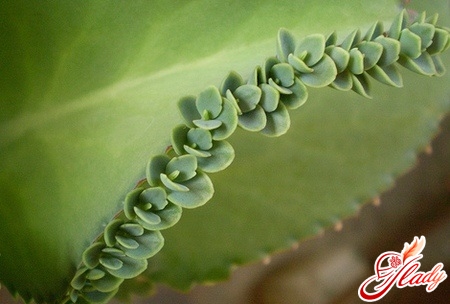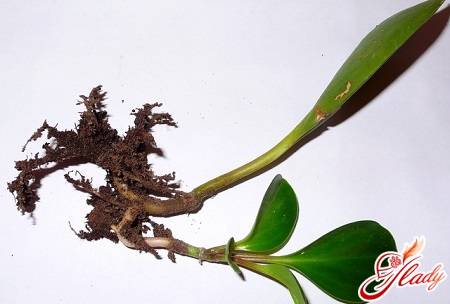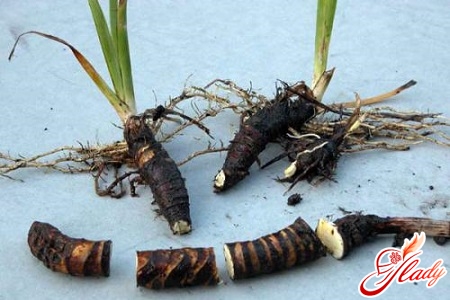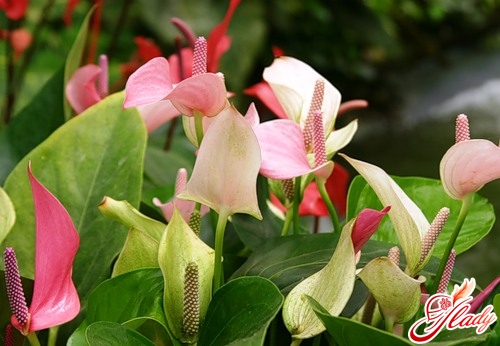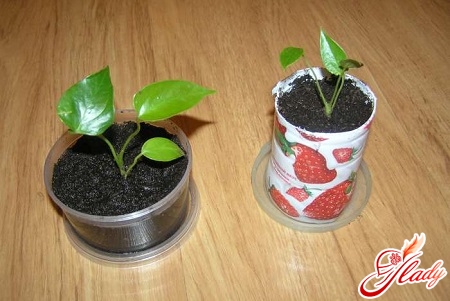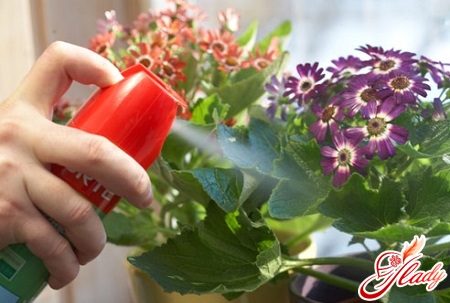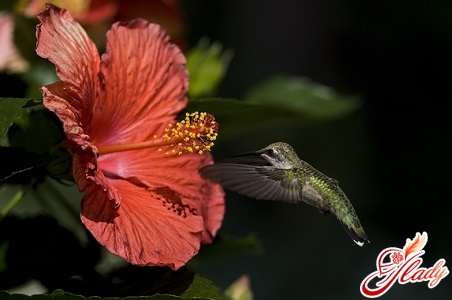 Homeland of hibiscus is China. That is why the people call this flower a Chinese rose. Also, the plant can be found in Western India and Polynesia. And some species grow in Africa and South America. In Malaysia hibiscus is considered a national flower - its buds symbolize the feminine. In the late 18th century, the flower was brought to Europe, and from there to Russia, where Chinese roses immediately won the hearts of flower growers. The plant is a large bush, under good conditions, reaching 3 meters in height. The young rose has a green trunk, the older it becomes, the larger the trunk area acquires a woody texture. Leaves are light green with a glossy surface, inflorescences have the shape of bells, the diameter of which is 10-12 centimeters. The color of the buds depends directly on the plant variety (from white to burgundy or purple). At home, you can rarely find a variety of colors buds. Usually it is red, pink and or yellow bells, blossoming no more than 2 days. However, a short bloom time with success compensates for its frequency. If the rose feels well in your apartment, its cultivation will not cause you any special problems - the flower will throw out the bud behind the bud for six months. What are the conditions for a beautiful rose for abundant flowering? How to care for her and what diseases are the most dangerous for her? Let's try to understand together, in all these subtleties. And start, as usual, from the very beginning - from reproduction.
Homeland of hibiscus is China. That is why the people call this flower a Chinese rose. Also, the plant can be found in Western India and Polynesia. And some species grow in Africa and South America. In Malaysia hibiscus is considered a national flower - its buds symbolize the feminine. In the late 18th century, the flower was brought to Europe, and from there to Russia, where Chinese roses immediately won the hearts of flower growers. The plant is a large bush, under good conditions, reaching 3 meters in height. The young rose has a green trunk, the older it becomes, the larger the trunk area acquires a woody texture. Leaves are light green with a glossy surface, inflorescences have the shape of bells, the diameter of which is 10-12 centimeters. The color of the buds depends directly on the plant variety (from white to burgundy or purple). At home, you can rarely find a variety of colors buds. Usually it is red, pink and or yellow bells, blossoming no more than 2 days. However, a short bloom time with success compensates for its frequency. If the rose feels well in your apartment, its cultivation will not cause you any special problems - the flower will throw out the bud behind the bud for six months. What are the conditions for a beautiful rose for abundant flowering? How to care for her and what diseases are the most dangerous for her? Let's try to understand together, in all these subtleties. And start, as usual, from the very beginning - from reproduction.
Secrets of Hibiscus Reproduction
It is worth noting that growing hibiscusalone will not be difficult. It propagates in two ways: seeds or cuttings. The latter method is considered the most optimal for amateur growers. The best time for reproduction is spring (April-May). So, where do you start growing a home rose? We cut a small twig from the top of an adult plant. It is desirable that the cutting be 2-3 pairs of leaves. Now we are preparing a soil mixture - we mix peat and sand in equal parts. The pot is chosen small, but deep, as the root system of the plant develops quite quickly. Be sure to use drainage (expanded clay), which is placed on the bottom of the pot with a two-centimeter layer. Next, we fill a third of the soil in the container, place the rose in it and gently distribute the rest of the soil. In order to hibiscus quickly let the roots, cover it with a glass jar, thereby creating a greenhouse effect. You should water the stalk every 4-3 days, simply adding water to the pan. The flower itself will determine how much fluid it needs to drink. As soon as the hibiscus releases a new leaf, the jar can be removed. That's all - consider that you coped with reproduction. There is another way to root the cuttings. Cut the sprig into a glass with purified water, previously diluted in it with a special powder - rootstock, which promotes the rapid appearance of rootlets. After the threads of the rootlets will tighten a third of the glass, you can transplant the rose into the ground. Both methods are good for reproduction at home. Which one to choose is up to you. 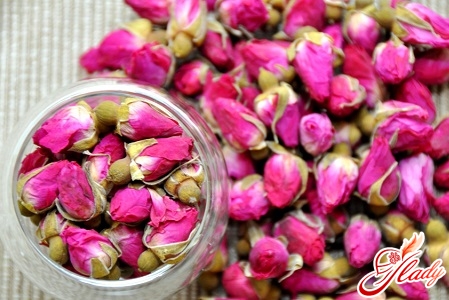
Optimal conditions for growing
- Watering
In the hot season, water procedures should beabundant. For irrigation, it is better to use purified, stand-by or rainwater (also pre-set) water. Allow soil to dry out, monitor its condition and moisten as needed. Otherwise, the plant will start to discard the leaves, wither and die. In winter, watering is reduced - once a week will be quite enough;
- Additional fertilizing
Top dressing is performed during growth (when the plantyoung) and in the period of each flowering. Fertilizers are introduced once a week. It can be biohumus - liquid organic fertilizer. Or any other, intended for indoor flowers and diluted strictly according to the instructions. Before buying, be sure to consult with the seller;
- Lighting
A Chinese rose loves well-lit places, butdoes not tolerate direct sunlight. Therefore, choose a place for it based on these parameters. If the light is not enough, the plant may not bloom or discard still unrevealed buds;
- Air temperature
The optimum temperature is 20-25 degrees. In winter, it should not fall below 12 degrees. If possible, take out a rose on an open balcony, veranda or courtyard. With too warm and dry air, hibiscus is sensitive to spraying the leaves. Therefore, this procedure is best done in the early morning or after sunset.
Chinese rose transplantation
The first 5-6 years of his life, the Chinese roseneeds an annual resettlement. Adult plants are transplanted every 3-4 years, as the root system grows. The transplant is carried out in the early spring. The soil should consist of humus, leaf and clayey-turf ground in the proportion 1: 1: 2. Also in the soil mixture it is desirable to add bird droppings and sand. Before transplanting the plant, cut off part of the root system. The branches of the plant also need pruning - shortly after the migration shorten them by about a third. All these manipulations will give impetus to the appearance of young shoots and to abundant flowering. In addition, the plant has a beautiful and neat crown. In a young plant, the crown is formed not by pruning, but by pinching the tips of the shoots. After the procedure, hibiscus should be placed in a well-lit place and abundantly watered. If all the necessary conditions are met, in a year you will have a beautiful and flowering tree on the windowsill. The Chinese rose blossoms mainly in spring and summer. If you want to postpone flowering for the winter period, do not change before the end of May. Until then, create an artificial rest period for the plant: put it in a shaded place and water it a little. After relocation, it is necessary to trim the tip and take care of it as usual. In mid-July pruning should be repeated. By autumn the plant will release new buds, flowering will begin in October and will last the whole winter. 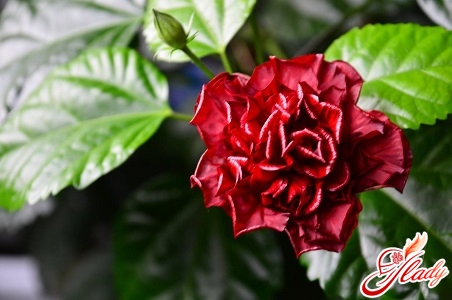
What pests threaten the plant?
Any serious diseases of hibiscus do not threaten. However, some pests may attack it. Care for a Chinese rose in this case should be special. So, how to get rid of pests?
- Spider mite
Very small insect, practically not noticeablewithout a magnifying glass. This red spider settles on the underside of the leaves and entangles them with its spider web. It can be seen with the naked eye. The tick is especially dangerous for those plants that spend a lot of time in the open air or in a place that is too warm and dry. At the first signs of the disease, you can treat the plant with a normal soap solution. If the pest is already fully attacked by the flower, it is better to use an insecticide solution;
- Aphid
This pest prefers to attackopen buds and young shoots. The aphids multiply very quickly, if you do not take timely measures, after a couple of days on your plant will live whole colonies of aphids. Fighting aphids can be by spraying sulfate-containing solution, which is sold in any flower shop. Knowing exactly how to care for a home rosette, you will certainly achieve its proper development and flowering. Believe me, this plant will take pride of place in your collection.




